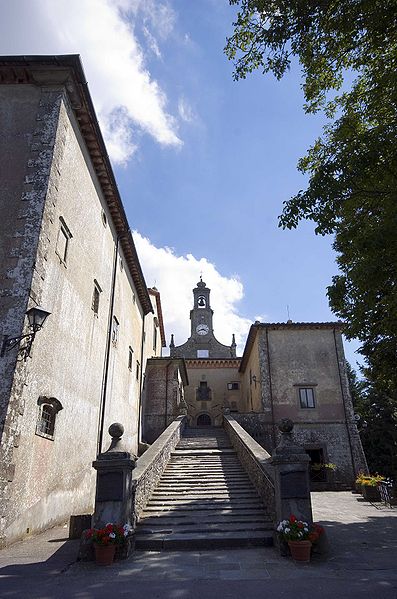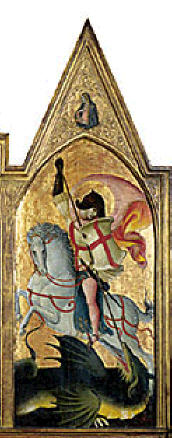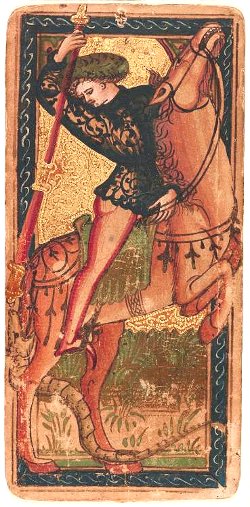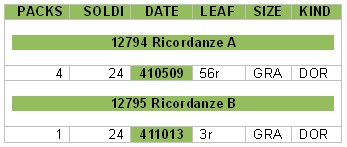
Two lions with cross seems to have been the general symbol ...
http://commons.wikimedia.org/wiki/Categ ... ella_Stufa
An ancestor list is given at ...
Vite di due beati della famiglia de' Lotteringhi Della Stufa cioè del b. Lotteringo dell'Ordine de' Servi di Maria e del b. Girolamo dell'Ordine de' Minori osservanti di S. Francesco con l'albero genealogico di detta nobilissima patrizia famiglia
Giuseppe Maria Brocchi (1687-1751)
http://books.google.de/books?id=5UHjqve ... fa&f=false
The Stufa family had "2 Beato" (as it is plural, it should be "2 Beati", which means "possible Saints in spe").
1. The first Stufa Beato is a man of 13th century ...
http://www.culturaitalia.it/viewItem.js ... 0900637019
by Castellucci Salvi (1608/ 1672), "Madonna con Bambino in gloria tra san Filippo Benizi e il Beato Lotteringo Della Stufa"
A second biography is given here ...
http://books.google.de/books?id=E0xDAAA ... go&f=false
... according which it seems, that he was born 1230/33, died in the year 1300 and was made a Beato in 1384.
He entered the "Ordine dei Servi di Maria (OSM)". In 1285 he followed Filippo Benizzi in the function of "Generale de' Servi". (compare the picture above: it shows the saint Benizzi and Lotteringo della Stufa]
Benizzi himself was beatified by Pope Leo X in 1515 (or 1645 ?) and made a saint in 1685 under the somewhat strange grand duke of Toscana, Cosimo III (who in modern times generally is considered as having been rather sick with his religious ideas). This happened around 1684 in Florence ...
http://en.wikipedia.org/wiki/Cosimo_III ... of_TuscanyThe Holy Roman Emperor requested Cosimo's participation in the Great Turkish War. At first, he resisted, but then sent a consignment of munitions to Trieste, and offered to join the Holy League.[38] They defeated the Turks at the Battle of Vienna in September 1683. To Cosimo's dismay, "many scandals and disorders continued to occur in the matter of carnal intercourse between Jews and Christian women, and especially putting their children out to be suckled by Christian nurses."[39] The Grand Duke, wishing to supplement the "foe of heretics" persona he acquired after Vienna, outlawed the practice of Jews using Christian wet-nurses and declared that if a Christian father wished to have his half-Jewish child suckled by a Christian nurse he must first apply to the government for a permit in writing.[39] In addition, public executions increased to six per day.[40] Gilbert Burnet, Bishop of Salisbury and a famed memorialist, visited this Florence in November 1685, of which he wrote that "[Florence] is much sunk from what it was, for they do not reckon that there are fifty thousand souls in it; the other states, that were once great republic, such as Siena and Pisa, while they retained their liberty, are now shrunk almost into nothing...
It's interesting to see, that the beatification of Lotteringo Stufa preceded that of Benizzi. The order "Servi di Maria" had possibly a connection to the far spread "wonders with pictures of Maria" around the region of Florence in this time, a movement, which after 1400 took a specific focus on a fresco in SS Annunciata ... see my report "Angel story ...
viewtopic.php?f=11&t=1007
... which became a great religious and touristic attraction and involved then also Cosimo Pater Patriae and the birth of Lorenzo de Medici in 1448/1449 (and likely not only then). Here ...
http://www.florin.ms/hareflorence5.html
.... I find the note "Beato Lottaringo, one of the seven founders of the S. Annunziata".
2. The second Stufa Beato lived during 14th century ...
http://www.culturaitalia.it/viewItem.js ... 0900637018
"Predica del Beato Girolamo Della Stufa"
Author is not given, but it's given to the same period (time of Cosimo III) as the picture of the other Stufa Beato. Likely both pictures were done in the preparaion of Benzzi as a new Florentine saint.
... and his biography is presented in a shorter way:
http://books.google.de/books?id=Uns5AAA ... fa&f=false


The biography gives "Convento di San Francesco in Fiesolo" as his start ...
http://it.wikipedia.org/wiki/Convento_d ... Fiesole%29
... and wiki tells about this location ..
We have, that Beato Girolamo della Stufa had been beatified in 1451 and that's a very interesting year, cause in 1450 the Franciscan San Bernardino had been made a saint, in a rather short time after his death (1444). Dates are missing in his biography, but it's said, that he talked much with Tomasso Scarlino ...Il convento di San Francesco è un convento francescano ... Su un preesistente romitorio sorse nel 1399 il convento francescano. Ad allora risalgono il protiro affrescato nel sottarco, il dormitorio di San Bernardino e uno dei due chiostri. Alla fine del Quattrocento la chiesa fu ingrandita nella parte absidale, costruendo il coro sopra la cappella sotterranea.
http://www.santiebeati.it/dettaglio/91227
... who lived c. 1370 - 1447 and became also Beato, but very late (1771).
Likely one has to conclude, that both promotions (San Bernardino and also that of Beato Girolamo) have their context in the growing popularity of the Franciscans during 15th century, which (after a long time without Franciscan pope) finally lead to pope Sixtus IV (1471), which had been a Franciscan pope. The Franciscans, as we know ...
viewtopic.php?f=11&t=740
... had specialized on their attacks against playing cards.
In the researched biography of Antonio di Dino Canacci, who is suspected to have been the playing card producer or playing card merchant "Antonio di Dino" from Franco Pratesi's Florentine lists, we have the curious situation, that Antonio di Dino was married to Pippa della Stufa, daughter of a family with Beati, and one of the both became Beati just in 1451, and Antonio di Dino (playing card producer) made his first sure Trionfi deck in 1452, though there are suspicions, that he possibly made already Trionfi decks 1445 and possibly 1441 and (if we extend the speculations) possibly already in 1439.
So I found it of interest to get clearer details about the della Stufa family. The above mentioned work of Giuseppe Maria Brocchi contains lists with della Stufa ancestors.They start at page 16:
http://books.google.de/books?id=5UHjqve ... &q&f=false

Lotto or Lottario (likely Lothar) came with emperor Otto III (16 years old in 996) in the year 998 (according report). Otto III established his cousin as new pope Gregory V. in 996, then 24 years old. Gregory crowned Otto. A 52-years-old anti-pope was chosen (997-998). A Pavia council decided for Gregory V. Otto III crashed the Roman rebellion (998) and reestablished Gregory. Gregory died 999, possibly by foul play. Gerbert was chosen, a lucky choice (a man with many new ideas, with qualities in arithmetic, mathematics, and astronomy and he reintroduced to Europe the abacus and armillary sphere). He became Pope Sylvestor II. A new rebellion in 1001. Otto died 1002, Gerbert died 1003.
Lothar, as it seems, established in Italy and became "Lotto".
***********

"B. Lotteringo" stands for the first Stufa Beato (1230-1300).



Ugo di Lotti (green) got a biography at treccani.it:
http://www.treccani.it/enciclopedia/ugo ... rafico%29/
He married a Medici daughter in 1326 and this marriage is said to have prepared the later good relations between della Stufa and Medici family.

A side line of the family, in which the second Stufa Beato Girolamo appeared. Of some relevance is also Lorenzo, who developed an own family (the second of two Florentine Stufa families), which in our case led - according the researches of Giuseppe Maria Brocchi - to Pippa, wife of Antonio di Dino Canacci, but according the research of a later genealogy researcher this must have been a mistake. Pippa had been the sister of Giovenco della Stufe, the Medici banker, and belonged to another part of the Stufa family (we come back to this point later).

Here we meet Andrea, ancestor of the one family, which interests us. He has a biography ...
Andrea della Stufa (+ in 1411, grandfather of banker Giovenco and his sister Pippa, ) has a long biography ...
http://www.treccani.it/enciclopedia/and ... rafico%29/
... and the biography notes for the testamento 4 considered sons: Ugo, Giovanni, Lorenzo and Lotteringo


The comments are not much ... however, the oldest son (?) Ugo gets an extended biography at treccani.it:
http://www.treccani.it/enciclopedia/ugo ... rafico%29/
He died in 1418, without direct heir (his brothers Lorenzo and Lotteringo got an annual payment).
Brother Giovanni seems to have been dead in 1412 already, only his son Niccolo seems to be considered, presented by a notary.1418, che i suoi eredi, i fratelli Lorenzo e Lotteringo, dessero annualmente al santuario di Montesenario sessanta staia di grano, quaranta barili di vino e 150 fiorini d'oro. La stessa moglie Niccolosa, che gli sopravvisse per qualche anno, dispose nel suo testamento a favore dei monaci di Montesenario un legato di 300 fiorini.
The twice mentioned Montesenario is this here ...
http://it.wikipedia.org/wiki/Santuario_di_Montesenario

In the text one can read ...
In the biography of Beato Lottorengo we read, that he was one of the Fondatori dell'ordinario dei Servi di Maria. As he was too young in 1234 (*1230 or 1233), one likely has to assume, that he was dedicated to work there already as a child, and the early "della Stufa" family (not clear, if they had the name already) seem to have one of the sponsors.Il convento fu eretto nel 1234 da sette nobili fiorentini, fondatori dell'ordine dei Servi di Maria, e perciò detti i Sette santi fondatori; fu ampliato nel XV secolo, e di nuovo nel 1594 dal granduca Ferdinando I, per essere poi in parte modificato nel XVIII e nel XIX secolo.
Further ...
1412 is one year after the death of the father Andrea, and Ugo had become head of the family. San Filippo Benizi we had already, the forerunner as the general of the order, before Beato Lottorengo took the position.A sinistra si affaccia la chiesa dell'Addolorata, dedicata anche a San Filippo Benizi, edificata nel 1412 dai della Stufa sul preesistente oratorio; completamente ristrutturata nel 1717, probabilmente sotto la direzione di Giovan Battista Foggini, con aggiunte e modificazioni successive; preceduta da un portico, è fiancheggiata dal campanile eretto nel 1648 e rinnovato alla fine del secolo XVIII.
Further ...
A hero of the family, who had a positive role, when Lorenzo de Medici was saved from the attack on his life in 1478.destra della porta di ingresso, monumento sepolcrale di Sigismondo della Stufa, dell'inizio del XVI secolo
**************
1427 - The catasto knows three households for the Della Stufa family in Florence. Other della Stufa families seem to exist outside of Florence.
1. Lorenzo di Andrea (47 years, married, 10 bocche, 6451)
2. Lotteringo di Andrea (42 years, married, 5 bocche, 6911)
3. Giovanni di Lorenzo (48 years, married, 10 bocche, 1371)
This Giovanni di Lorenzo is from another part of the family, with, as the money notes explain, less money than the other part. Pippa (wife of Antonio di Dino Canacci) is said to have been daughter of Niccolo, son of this Giovanni di Lorenzo. But she isn't.
This I'll explain in my next post.

















